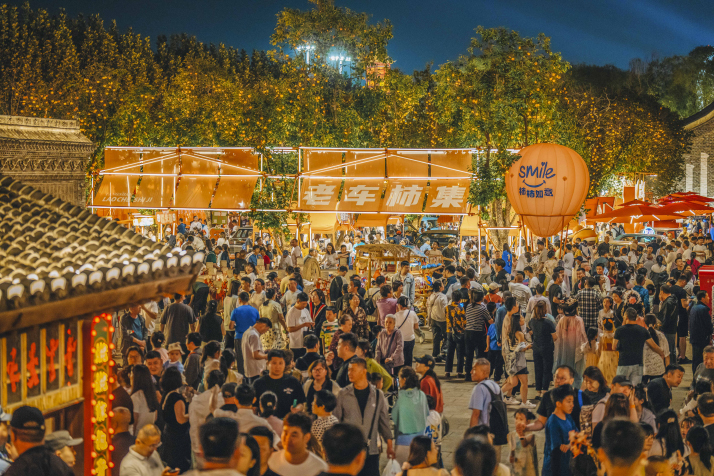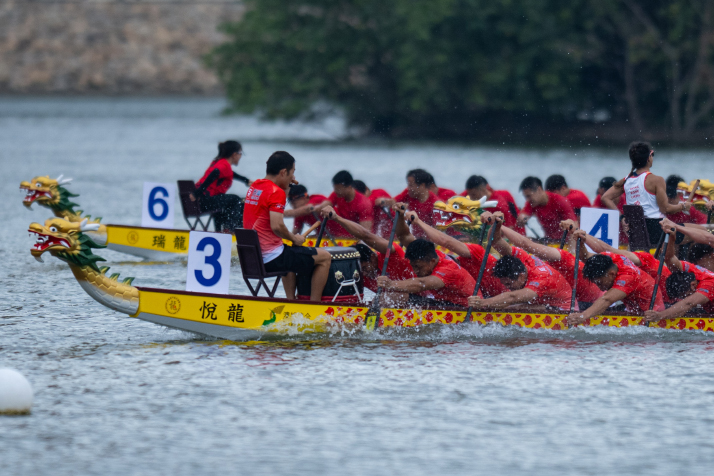| China |
| How an ancient festival fuels the modern economy | |
|
|
 Tourists enjoy themselves in Hetou Old Street in Fengnan District, Tangshan City, Hebei Province, on June 2 (XINHUA)
Ancient traditions continue to shape modern consumer behavior and mindsets in China. The Dragon Boat Festival holiday, which fell on May 31 to June 2 this year, provides a great example. Over two millennia ago, ancient Chinese people cast glutinous rice dumplings (zongzi) into rivers to prevent aquatic creatures from eating the body of Qu Yuan, the revered poet-patriot of the Warring States Period (475–221 B.C.) who drowned himself in the Miluo River in despair after learning that the capital of his motherland had been captured by enemy troops. Since then, elaborate dragon boat races have been held on rivers to commemorate him, while households hang bundled mugwort on their doorways—a practice believed to ward off epidemics, and repel insects as well as malevolent forces. Today, to celebrate the festival, consumers flock to e-commerce platforms and supermarkets to snap up trendy zongzi in all kinds of flavors and packaging. Once a humble herb, mugwort now graces the shelves of trendy gift and flower shops. Dragon boat races, steeped in tradition, have evolved into tourist attractions. These age-old traditions, reshaped by modern commercialization and people's evolving needs for entertainment, have now become engines fueling a vibrant festival economy. "The Dragon Boat Festival is the last public holiday in the first half of the year," Dai Bin, head of the China Tourism Academy, told China Media Group. "During recent traditional holidays, folk customs, intangible cultural heritage and family-friendly trips emerged as new highlights that drew visitors. In particular, dragon boat races in south China and activities related to the festival's folk customs across the country were very popular with tourists," he added.  Athletes compete in a dragon boat race in Macao Special Administrative Region, on May 31(XINHUA)
Traditional engines The Dragon Boat Festival holds unique cultural significance for the Chinese people. In 2009, it became China's first traditional festival inscribed on UNESCO's Intangible Cultural Heritage list. During the holiday period this year, the market demonstrated remarkable enthusiasm for related folk activities and festival-themed products. Booking platform Tongcheng Travel reported page views for guides to domestic intangible cultural heritage markets increased over 300 percent year on year during the holiday period. "We brought our child to watch the Dragon Boat Festival races and experience the tradition firsthand," Beijing resident Liu Mengying told Beijing Review on the bank of the Grand Canal section in Beijing's Tongzhou District. The high-profile event, held along the Grand Canal section in Tongzhou during the three days of the festival, featured Lingnan-style dragon boat performances, boat tug-of-war competitions, as well as cultural tourism activities celebrating the canal's heritage. Lingnan is the region south of the Wuling Mountains in south China, encompassing the areas of modern-day Guangdong and Hainan provinces, Guangxi Zhuang Autonomous Region, and Hong Kong and Macao special administrative regions. Historically, due to the natural barrier formed by these mountains, Lingnan developed a unique Dragon Boat Festival culture, particularly in its dragon boat racing. This includes distinctive boat craftsmanship and elaborate ceremonial rituals. "We believe it's crucial for children to engage with China's cultural tradition, so that they will remember the impressive scenes along with the patriotic spirit behind this festival," Liu explained. "We've booked a DIY zongzi workshop where we'll learn to make the festival food together after watching the races." On May 31, Zhenyuan County in Qiandongnan Prefecture of Guizhou Province not only hosted dragon boat races but also pioneered interactive programs allowing tourists to paddle the boats with professional athletes to compete for festival-themed prizes. "The hands-on dragon boat experience exceeded our expectations in popularity," Jia Meiqian, Director of Zhenyuan's Tourism Service Center, told newspaper Guizhou Daily. "Many visitors, despite having no prior paddling skills, were drawn to this immersive cultural activity." Jia added that the initiative's appeal extended beyond Guizhou, attracting participants from other regions like Chongqing Municipality and Jiangsu Province to admire Guizhou's distinct culture. At the Nanyuan Wetland Forest Park in Beijing's Fengtai District, crowds gathered at the DIY workshops to craft mugwort ornaments, hand-painted fans and aromatic sachets. At the event, a park staff member introduced the functions and scents of traditional herbs used in Dragon Boat Festival sachets, including mint, Chinese angelica, perilla leaves, mugwort and patchouli. They then demonstrated how to make these aromatic sachets step by step. After receiving the tools, embroidered sachet pouches, and pre-measured dried herb blends, visitors scattered to different stalls to create their own. "Our family package includes materials for all these festival crafts, costing just 49 yuan ($6.8)," one of the staff at the workshop told Beijing Review. "These activities are incredibly popular. People believe handmade gifts carry special meaning, and are perfect for sharing with loved ones during the holidays." These vibrant activities have significantly boosted holiday travel. According to the statistics released by the Ministry of Transport on June 2, total cross-regional trips during the Dragon Boat Festival holiday reached 657 million, averaging 219 million daily and demonstrating a 3-percent increase from the same holiday period last year. "The preference for short-haul trips and local leisure activities made high-speed rail and self-driving the dominant modes of travel. Many families are postponing major trips to summer as the travel peak approaches," Dai explained. "Meanwhile, some travelers are opting for niche attractions, fueling tourism growth in smaller cities and county hubs." Innovative forces Alongside classic festival staples, a wave of innovative products featuring contemporary flavors, functional upgrades and increased aesthetic appeal, has ignited consumer demand, giving retail economies a significant lift. E-commerce platform Tmall reported that holiday sales of products related to the festival or the season surged over 130 percent month on month. While traditional zongzi fillings like sweet red bean paste, and pork and salted egg yolk remain staples, bold new varieties are captivating younger shoppers: sugar-free purple yam and oat zongzi, spicy crayfish zongzi, and flower-infused options like jasmine-taro zongzi. "I remember when I was a child, holiday treats such as zongzi and moon cakes came with traditional flavors, and in heavy gift boxes that were unnecessary and not environmentally friendly," Beijing resident Chen Xuening told Beijing Review. "I love the zongzi products now—in simple packaging and in all kinds of surprising flavors. If we want to wrap up a box for relatives, there are tailored packaging services." Mugwort and other medicinal herbs, once simply hung by doorways, now fuel an extended value chain as they come in boutique bouquets and artisanal sachets. In Wuchuan Gelao and Miao Autonomous County in Guizhou, farmers harvest emerald-green mugwort for processing, with one factory manager revealing ambitious 2025 targets to China Media Group, "We plan to source 2,000 metric tons of mugwort to produce 2 tons of essential oil." The county's more than 7,000 hectares of mugwort fields now yield over 40 kinds of derivative products, from moxa sticks to herbal teas and therapeutic bath bundles. At the Timeless Flowers florist in Langfang, Hebei Province, festival-themed arrangements have become the runaway bestsellers. "Decorative bouquets have gained popularity over the past two years," the shop manager told Beijing Review. The store crafts arrangements using mugwort, butcher's broom, wheat stalks, hosta leaves, and eucalyptus—accented with bells, gourds, ribbons, sequins and sachets. These elements are tailored into bouquets, gift boxes or miniature baskets based on customer preferences. "Young consumers are redefining holiday rituals," the manager noted. "They're blending tradition with contemporary aesthetics to create new ceremonial experiences—and it is their way of promoting traditional culture. As business managers, we must catch onto the trends of the times." Copyedited by G.P. Wilson Comments to zhangyage@cicgamericas.com |
|
||||||||||||||||||||||||||||
|